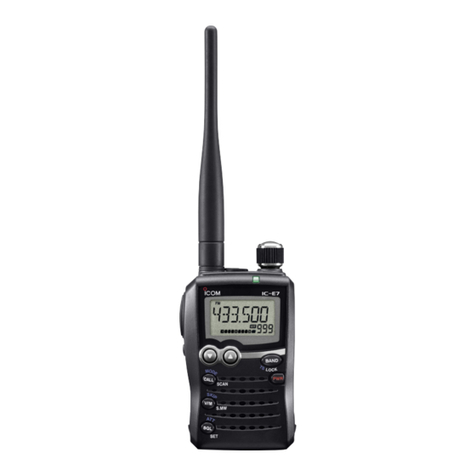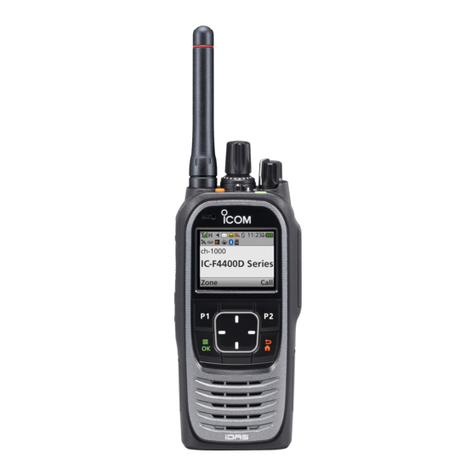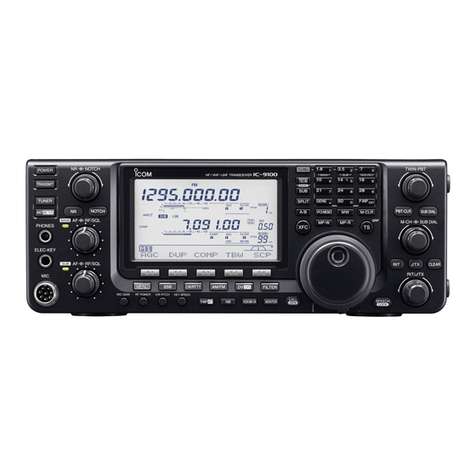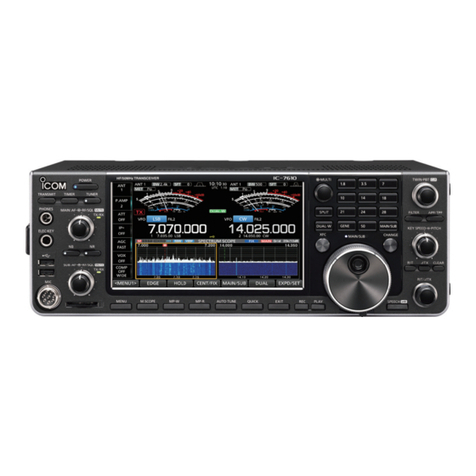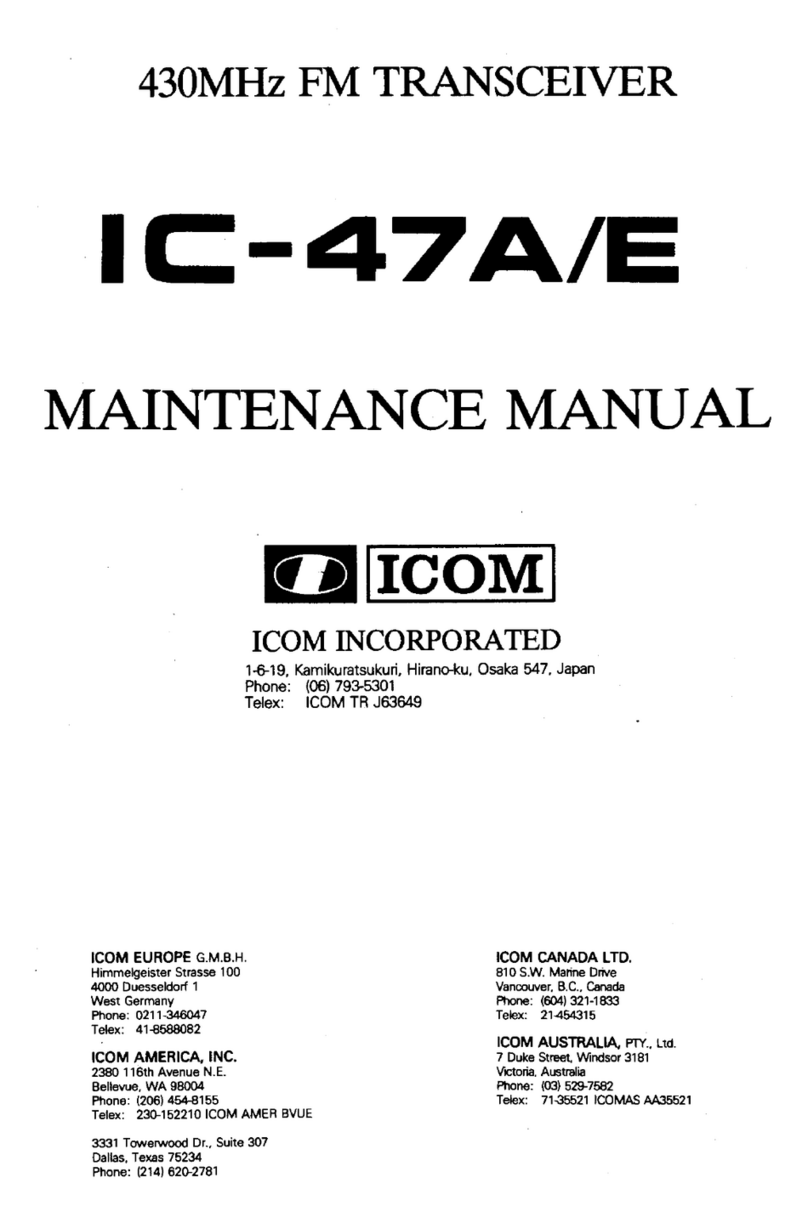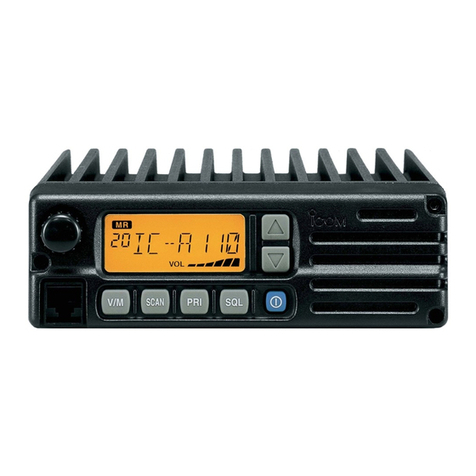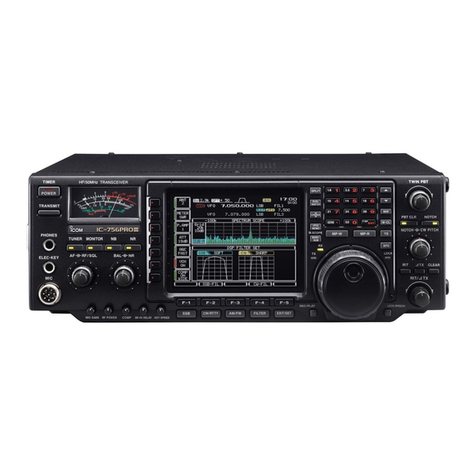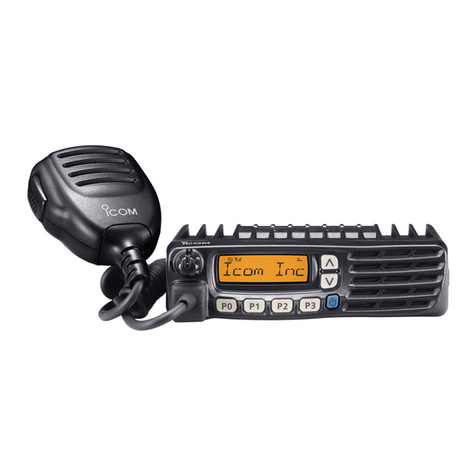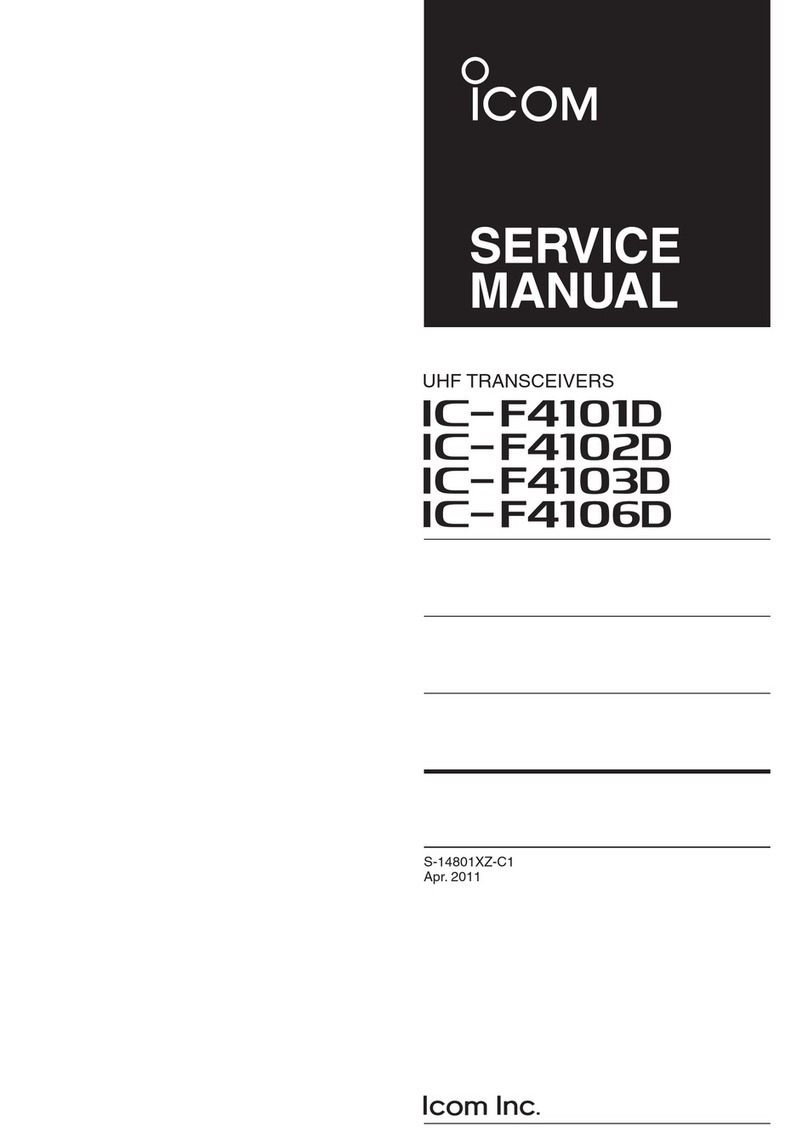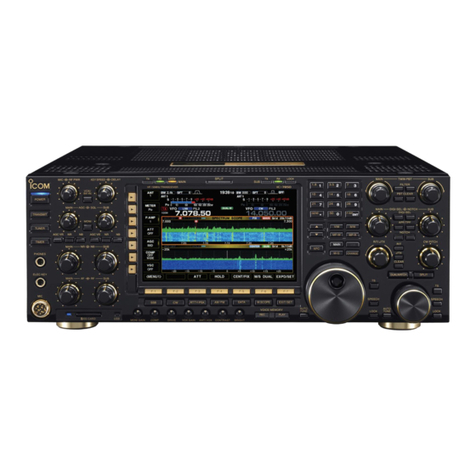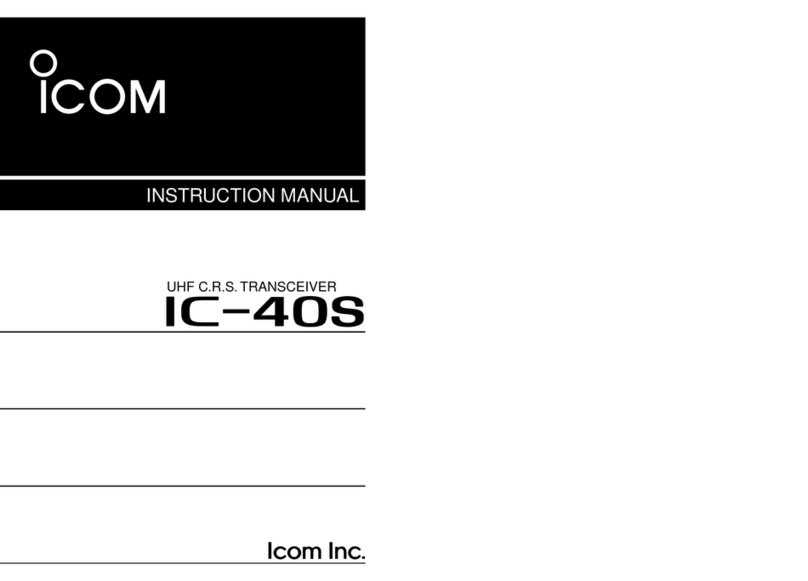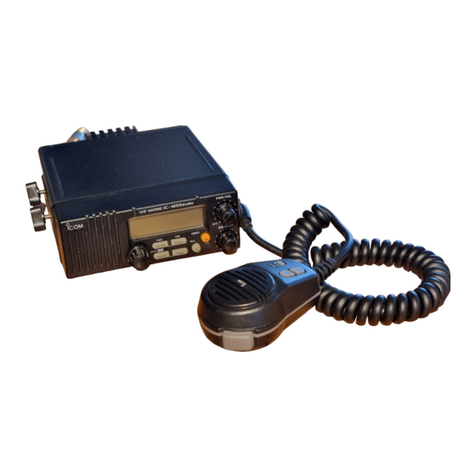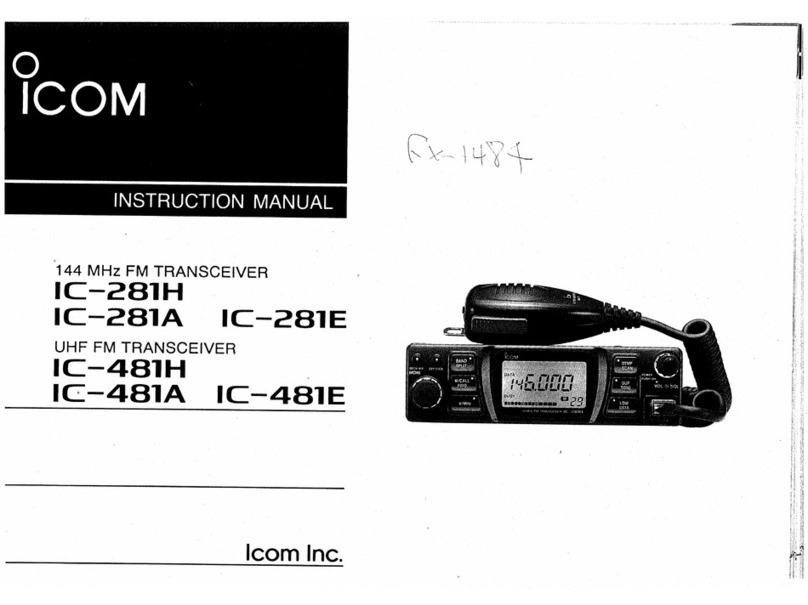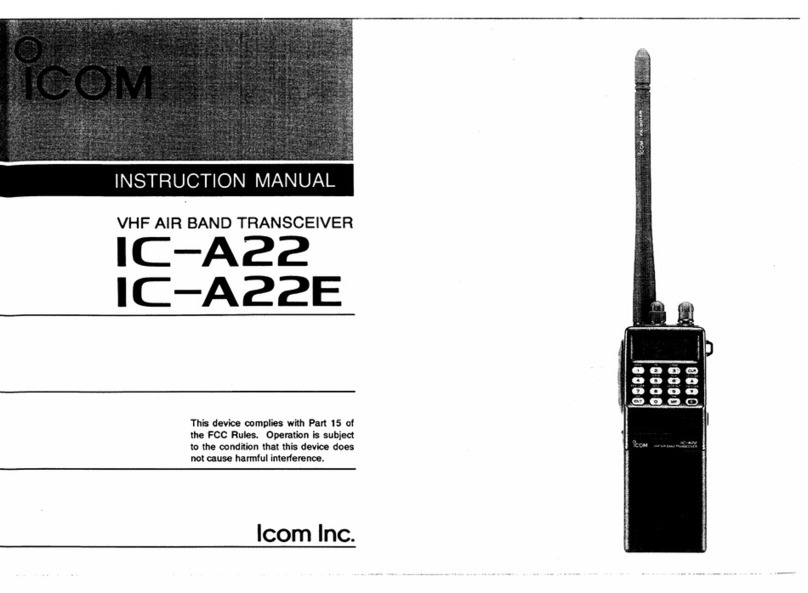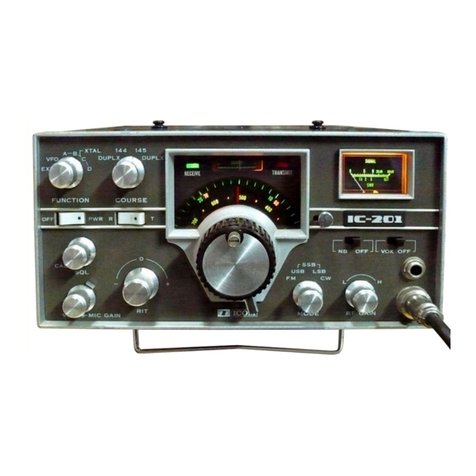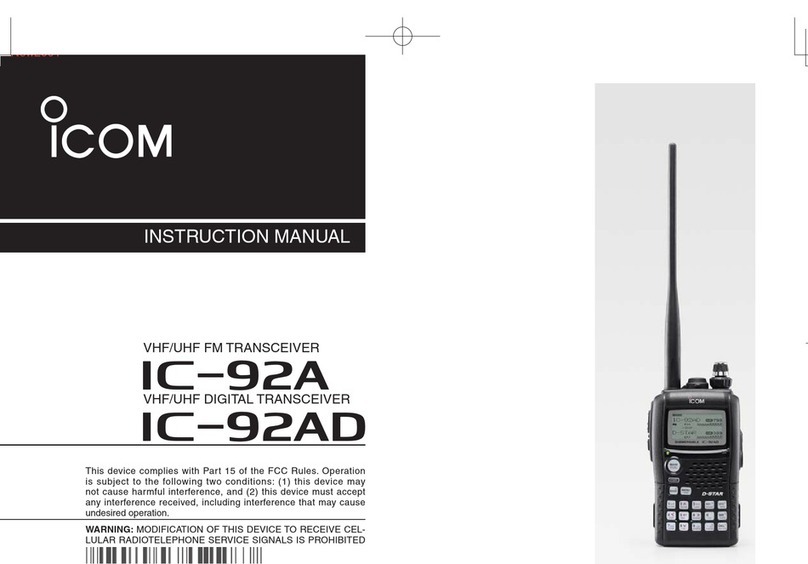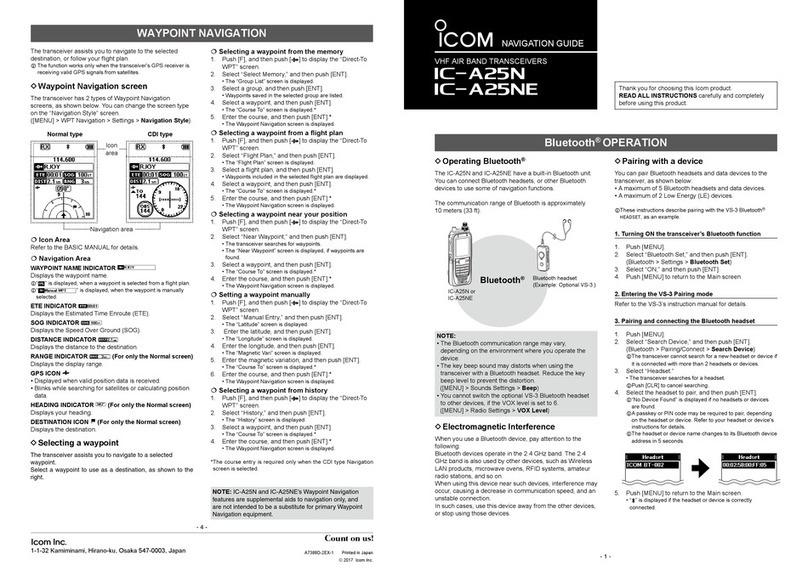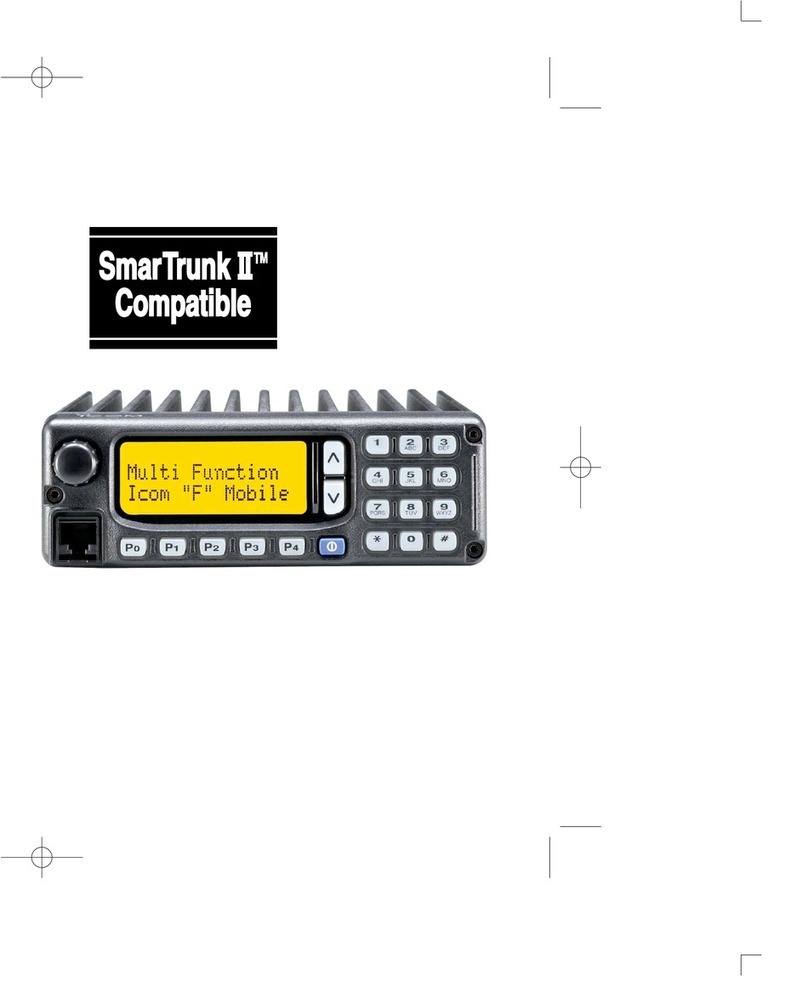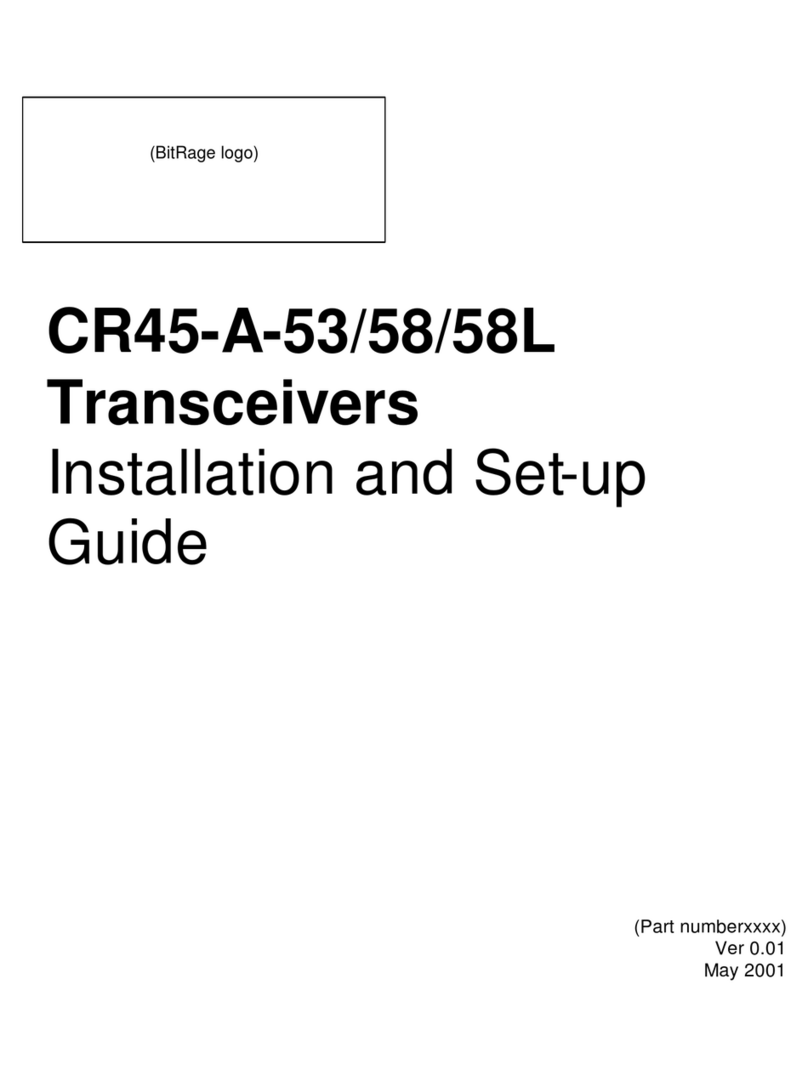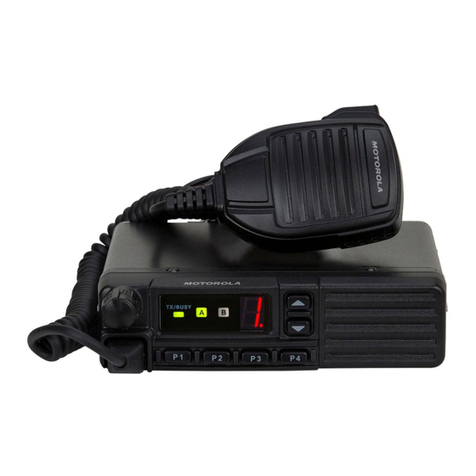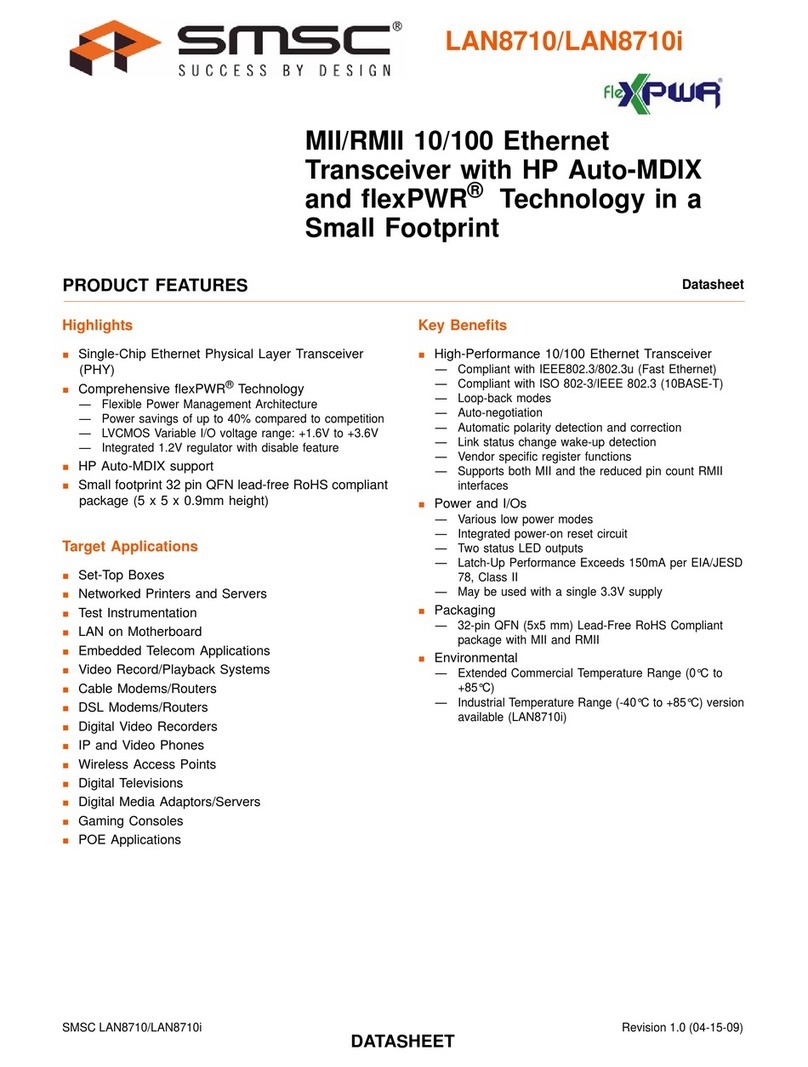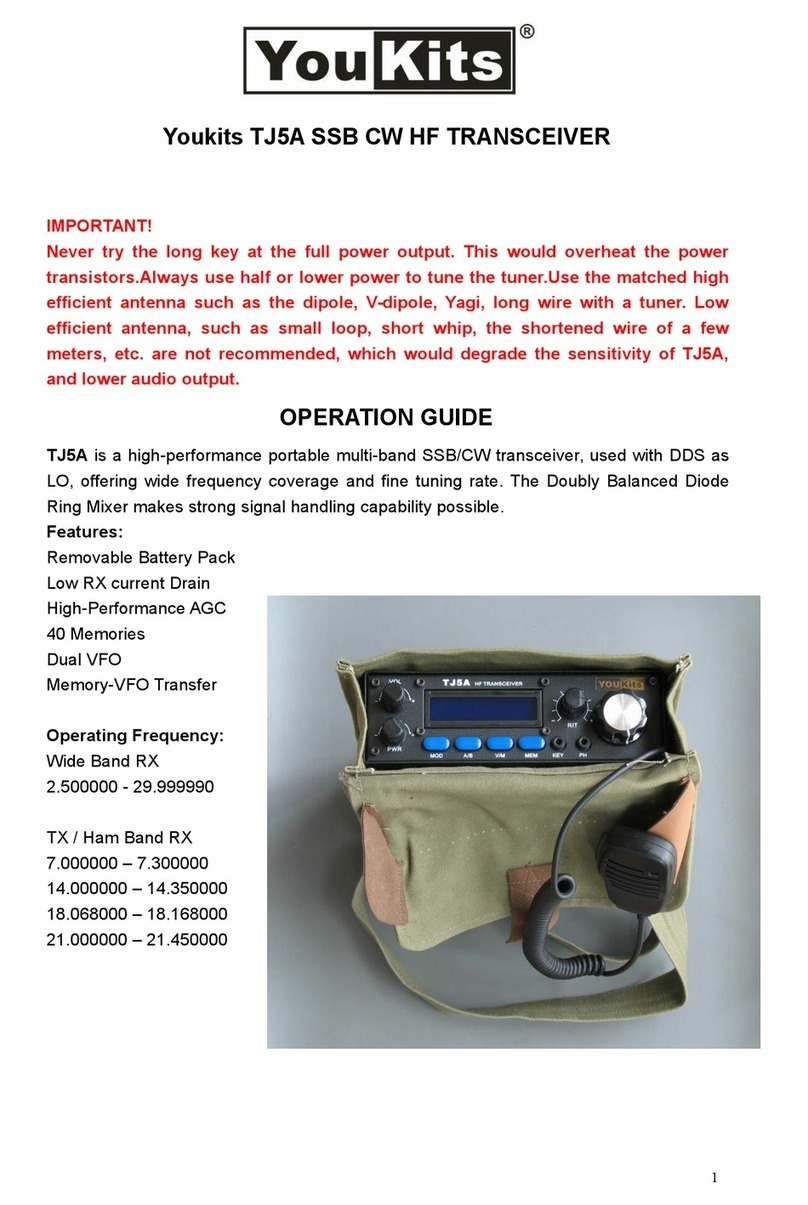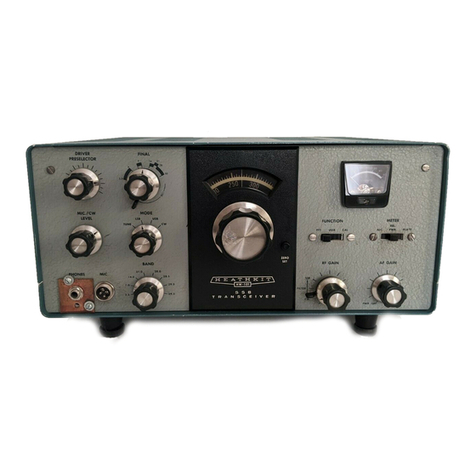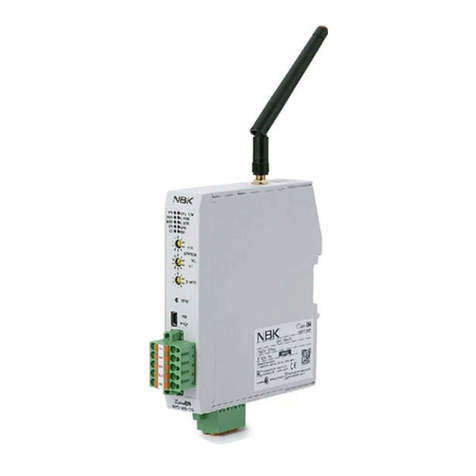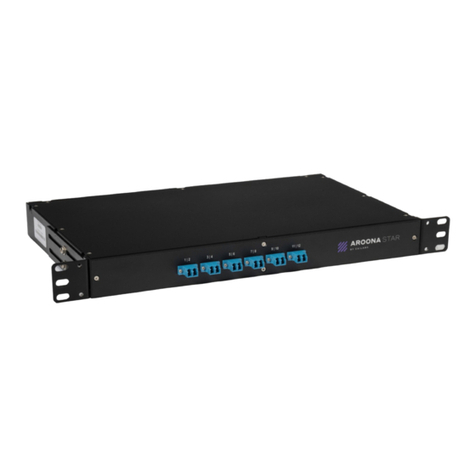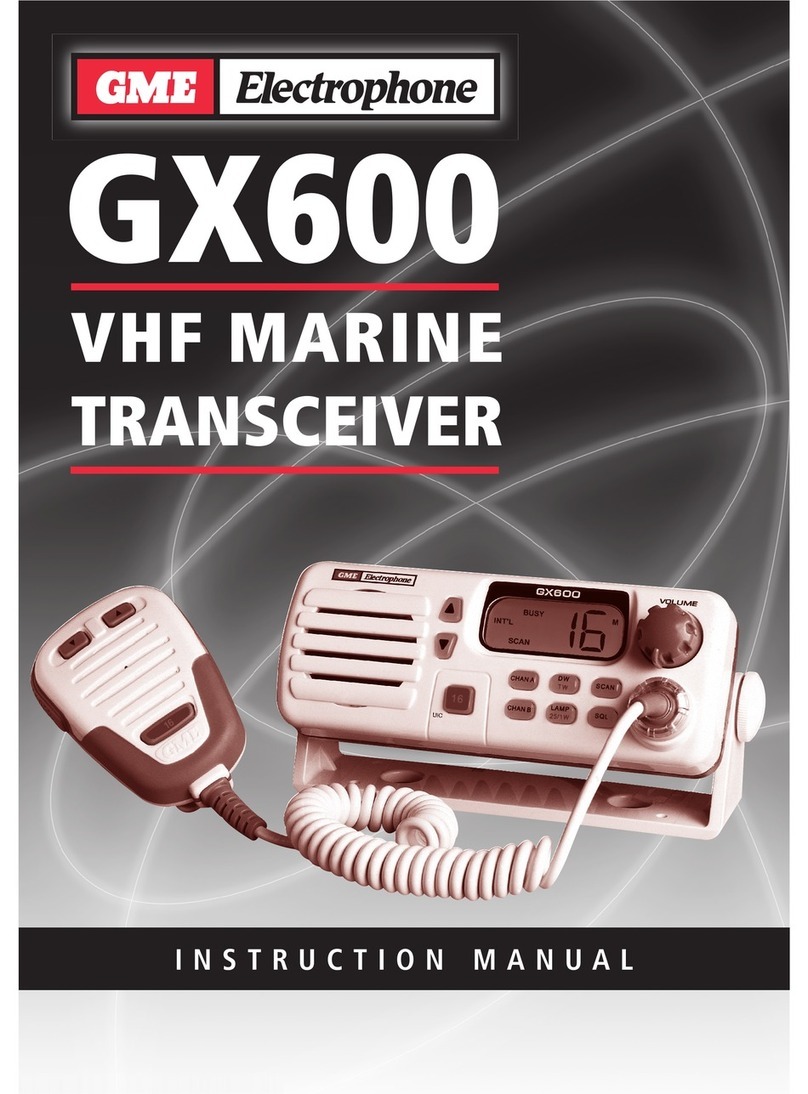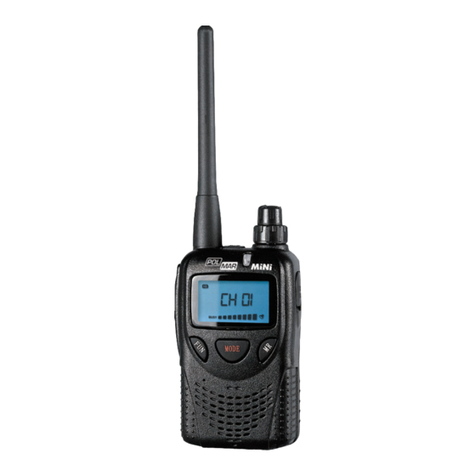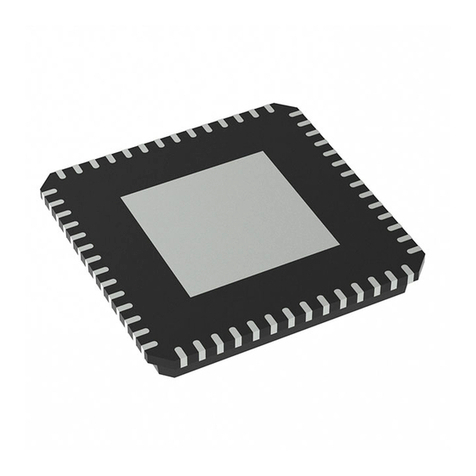Icom IC-7600 User manual

INSTRUCTION MANUAL
HF/50 MHz TRANSCEIVER
i7600

i
FOREWORD
Thank you for making the IC-7600 your radio of
choice. We hope you agree with Icom’s philosophy of
“technology first.” Many hours of research and devel-
opment went into the design of your IC-7600.
FEATURES
❍Ultimate receiver performance: third-order inter-
cept (IP3) of +30 dBm (HF bands only)
❍Built-in Baudot RTTY and PSK modulator/demodu-
lator and direct PC keyboard connection capability
for RTTY and PSK operations without a PC
❍High resolution spectrum scope— center frequency
and fixed frequency modes, plus mini-scope dis-
plays
❍USB connectors on front and rear panels
❍Large LCD with LED backlight
IMPORTANT
READ THIS INSTRUCTION MANUAL
CAREFULLY before attempting to operate the
transceiver.
SAVE THIS INSTRUCTION MANUAL. This
manual contains important safety and operating
instructions for the IC-7600.
EXPLICIT DEFINITIONS
WORD DEFINITION
RDANGER Personal death, serious injury or an
explosion may occur.
RWARNING Personal injury, fire hazard or electric
shock may occur.
CAUTION Equipment damage may occur.
NOTE
If disregarded, inconvenience only. No risk
of personal injury, fire or electric shock.
Spurious signals may be received near the following
frequencies. These are made in the internal circuit
and does not indicate a transceiver malfunction.
10.4923MHz, 24.576MHz
SUPPLIED ACCESSORIES
The transceiver comes with the following accessories.
Qty.
q Hand microphone ............................................ 1
w DC power cable ............................................... 1
e Spare fuse (ATC 5 A) ...................................... 1
r Spare fuse (ATC 30 A) .................................... 2
t6.35 (d) mm plug...............................................1
q
e
t
w
r
FCC INFORMATION
• FOR CLASS B UNINTENTIONAL RADIATORS:
This equipment has been tested and found to comply
with the limits for a Class B digital device, pursuant to
part 15 of the FCC Rules. These limits are designed
to provide reasonable protection against harmful
interference in a residential installation. This equip-
ment generates, uses and can radiate radio frequency
energy and, if not installed and used in accordance
with the instructions, may cause harmful interference
to radio communications. However, there is no guar-
antee that interference will not occur in a particular
installation. If this equipment does cause harmful
interference to radio or television reception, which can
be determined by turning the equipment off and on,
the user is encouraged to try to correct the interfer-
ence by one or more of the following measures:
• Reorient or relocate the receiving antenna.
• Increase the separation between the equipment
and receiver.
•Connect the equipment into an outlet on a
circuit different from that to which the receiver is
connected.
• Consult the dealer or an experienced radio/TV
technician for help.
Icom, Icom Inc. and the Icom logo are registered trademarks of
Icom Incorporated (Japan) in the United States, the United King-
dom, Germany, France, Spain, Russia and/or other countries.
Microsoft, Windows and Windows Vista are either registered trade-
marks or trademarks of Microsoft Corporation in the United States
and/or other countries.
All other products or brands are registered trademarks or trade-
marks of their respective holders.

PRECAUTIONS
RWARNING HIGH RF VOLTAGE! NEVER
attach an antenna or internal antenna connector
during transmission. This may result in an electrical
shock or burn.
RWARNING! NEVER operate the transceiver
with a headset or other audio accessories at high
volume levels. Hearing experts advise against continu-
ous high volume operation. If you experience a ringing
in your ears, reduce the volume or discontinue use.
RWARNING! Immediately turn the transceiver
power OFF and remove the power cable if it emits an
abnormal odor, sound or smoke. Contact your Icom
dealer or distributor for advice.
CAUTION! NEVER put the transceiver in any
unstable place (such as on a slanted surface or
vibrated place). This may cause injury and/or damage
to the transceiver.
CAUTION! NEVER change the internal settings of
the transceiver. This may reduce transceiver perfor-
mance and/or damage to the transceiver.
In particular, incorrect settings for transmitter circuits,
such as output power, idling current, etc., might
damage the expensive final devices.
The transceiver warranty does not cover any prob-
lems caused by unauthorized internal adjustment.
CAUTION! NEVER apply AC power to the
[DC13.8V] socket on the transceiver rear panel. This
could cause a fire or damage the transceiver.
CAUTION! NEVER apply more than 16 V DC,
such as a 24 V battery, to the [DC13.8V] socket on
the transceiver rear panel. This could cause a fire or
damage the transceiver.
CAUTION!
NEVER let metal, wire or other objects
protrude into the transceiver or into connectors on the
rear panel. This may result in an electric shock.
CAUTION! NEVER block any cooling vents on
the top, rear or bottom of the transceiver.
CAUTION! NEVER expose the transceiver to
rain, snow or any liquids.
CAUTION!
NEVER install the transceiver in a
place without adequate ventilation. Heat dissipation
may be reduced, and the transceiver may be damaged.
CAUTION! NEVER operate or touch the trans-
ceiver with wet hands. This may result in an electric
shock or damage to the transceiver.
DO NOT use chemical agents such as benzine
or alcohol when cleaning the IC-7600, as they can
damage the transceiver’s surfaces.
DO NOT push the PTT switch when you don’t actu-
ally desire to transmit.
DO NOT use or place the transceiver in areas with
temperatures below ±0°C (+32°F) or above +50°C
(+122°F).
DO NOT place the transceiver in excessively dusty
environments or in direct sunlight.
DO NOT place the transceiver against walls or
putting anything on top of the transceiver. This may
overheat the transceiver.
Always place unit in a secure place to avoid inadver-
tent use by children.
BE CAREFUL! If you use a linear amplifier, set the
transceiver’s RF output power to less than the linear
amplifier’s maximum input level, otherwise, the linear
amplifier will be damaged.
BE CAREFUL! The rear panel will become hot when
operating the transceiver continuously for long peri-
ods of time.
Use Icom microphones only (supplied or optional).
Other manufacturers’ microphones have different pin
assignments, and connection to the IC-7600 may
damage the transceiver or microphone.
The LCD display may have cosmetic imperfections
that appear as small dark or light spots. This is not a
malfunction or defect, but a normal characteristic of
LCD displays.
During maritime mobile operation, keep the trans-
ceiver and microphone as far away as possible from
the magnetic navigation compass to prevent errone-
ous indications.
Turn the transceiver power OFF and/or disconnect
the DC power cable when you will not use the trans-
ceiver for long period of time.
For U.S.A. only
CAUTION: Changes or modifications to this device,
not expressly approved by Icom Inc., could void your
authority to operate this device under FCC regula-
tions.
ii
1
2
3
4
5
6
7
8
9
10
11
12
13
14
15
16
17
18
19
20
21

iii
TABLE OF CONTENTS
FOREWORD..............................................................i
IMPORTANT...............................................................i
EXPLICIT DEFINITIONS............................................i
SUPPLIED ACCESSORIES.......................................i
FCC INFORMATION..................................................i
PRECAUTIONS......................................................... ii
TABLE OF CONTENTS...........................................iii
1 PANEL DESCRIPTION...................................1−15
■ Front panel........................................................1
■ Rear panel.......................................................11
■ LCD display.....................................................13
■ Screen menu arrangement .............................15
2 INSTALLATION AND CONNECTIONS........16−24
■ Unpacking.......................................................16
■ Selecting a location.........................................16
■ Grounding .......................................................16
■ Antenna connection ........................................16
■ Required connections .....................................17
D Front panel..................................................17
D Rear panel..................................................17
■ Advanced connections....................................18
D Front panel..................................................18
D Rear panel— 1............................................18
D Rear panel— 2............................................19
■ USB connection ..............................................19
■ Power supply connections...............................20
■ External antenna tuner connection .................20
■ Linear amplifier connections ...........................21
D Connecting the IC-PW1/EURO...................21
D Connecting a non-Icom linear amplifier......21
■ Transverter jack information ............................22
■ FSK and AFSK (SSTV) connections...............22
D FSK operation—
when connecting to [ACC 1].......................22
D AFSK operation ..........................................22
D When connecting to the [USB] connector...22
■ Microphone connector information..................23
■ Microphones....................................................23
D HM-36.........................................................23
D SM-50 (Option)...........................................23
■ Accessory connector information....................24
3 BASIC OPERATION.....................................25−37
■ Before first applying power..............................25
■ Applying power (CPU resetting)......................25
■ Selecting VFO/memory mode.........................26
■ Main/Sub band selection.................................26
D Main/Sub band switching............................26
D Main/Sub band equalization .......................26
■ Selecting an operating band ...........................27
D Using the band stacking registers...............27
■ Frequency setting............................................28
D Tuning with the main dial.............................28
D Direct frequency entry with the keypad.......28
D About 5 MHz band operation
(USA version only)......................................29
D Quick tuning step........................................29
D Selecting “kHz” step....................................29
D Selecting 1 Hz step.....................................30
D Auto tuning step function............................30
D 1⁄4 tuning step function...............................30
D Band edge warning beep............................31
■ Operating mode selection...............................32
■ Squelch and receive (RF) sensitivity...............33
■ Volume setting.................................................34
■ Meter indication selection................................34
D Multi-function digital meter..........................34
D Meter type selection....................................35
■ Voice synthesizer operation.............................35
■ Basic transmit operation..................................36
D Transmitting.................................................36
D Microphone gain adjustment.......................36
D Drive gain adjustment.................................37
4 RECEIVE ANDTRANSMIT..........................38−89
■ Functions for CW operation.............................38
D About CW reverse mode.............................38
D About CW pitch control...............................38
D CW sidetone function..................................38
D APF (Audio Peak Filter) operation ..............39
■ Electronic keyer functions ...............................40
D Memory keyer screen .................................41
D Editing a memory keyer..............................42
DContest number set mode ..........................43
DKeyer set mode...........................................44

TABLE OF CONTENTS
■ RTTY (FSK) operation.....................................46
D About RTTY reverse mode.........................47
D Twin peak filter............................................47
D
Functions for the RTTY decoder indication
..48
D Setting the decoder threshold level.............48
D RTTY memory transmission.......................49
D Automatic transmission/reception setting ...49
D Editing RTTY memory ................................50
DRTTY decode set mode..............................51
DData saving.................................................53
■ PSK operation.................................................54
D About BPSK and QPSK modes..................55
D Functions for the PSK decoder indication...56
D Setting the decoder threshold level.............56
D PSK memory transmission.........................57
D Automatic transmission/reception setting ...57
D Editing PSK memory ..................................58
DPSK decode set mode................................59
DData saving.................................................61
■ Repeater operation .........................................62
D Repeater access tone frequency setting ....62
■ Tone squelch operation...................................63
■ Data mode (AFSK) operation..........................64
■ Spectrum scope screen ..................................65
D Center mode...............................................65
DFixed mode.................................................66
DMini scope screen indication.......................67
DScope set mode..........................................67
■ Preamplifier.....................................................72
■ Attenuator........................................................72
■ RIT function.....................................................73
D RIT monitor function ...................................73
■ AGC function...................................................74
D Selecting the preset value ..........................74
D
Setting the AGC time constant preset value
..74
■ Twin PBT operation.........................................75
■ IF filter selection..............................................76
D IF filter selection..........................................76
D Filter passband width setting
(except FM mode).......................................76
D Roofing filter selection ................................77
D DSP filter shape..........................................77
D Filter shape set mode.................................78
■ Dualwatch operation........................................79
■ Noise blanker ..................................................81
D NB set mode...............................................81
■ Noise reduction...............................................82
■ Dial lock function.............................................82
■ Notch function.................................................83
■ Auto tune function ...........................................83
■ VOX function....................................................84
D Using the VOX function...............................84
D Adjusting the VOX function .........................84
■ Break-in function.............................................85
D Semi break-in operation..............................85
DFull break-in operation................................85
■ Speech compressor........................................86
■ Transmit filter width setting..............................86
■ ∂TX function ...................................................87
D ∂TX monitor function..................................87
■ Monitor function...............................................87
■ Split frequency operation ................................88
■ Quick split function..........................................89
D Split lock function........................................89
5 VOICE RECORDER FUNCTIONS ...............90−98
■ About digital voice recorder.............................90
■ Recording a received audio ............................91
D Basic recording...........................................91
DOne-touch recording...................................91
■ Playing the recorded audio..............................92
D Basic playing...............................................92
DOne-touch playing.......................................92
■ Protect the recorded contents.........................93
■ Erasing the recorded contents........................93
■ Recording a message for transmit ..................94
D Recording ...................................................94
DConfirming a message for transmit.............94
■ Programming a memory name........................95
■ Sending a recorded message.........................96
D Transmit level setting...................................96
■ Voice set mode................................................97
■ Saving a voice message
into the USB-Memory......................................98
D Saving the received audio memory ............98
DSaving theTX memory ...............................98
iv
1
2
3
4
5
6
7
8
9
10
11
12
13
14
15
16
17
18
19
20
21

v
TABLE OF CONTENTS
6 MEMORY OPERATION..............................99−104
■ Memory channels............................................99
■ Memory channel selection ..............................99
D Using the [∫]/[√] keys................................99
D Using the keypad........................................99
■ Memory list screen........................................100
D Selecting a memory channel
using the memory list screen....................100
D
Confirming programmed memory channels
..100
■ Memory channel programming .....................101
D Programming inVFO mode ......................101
D Programming in memory mode ................101
■ Frequency transfers......................................102
D Transferring in VFO mode........................102
D Transferring in memory mode...................102
■ Memory names .............................................103
D Editing (programming) memory names ....103
■ Memory clearing............................................103
■ Memo pads ...................................................104
D Writing frequencies and operating modes
into memo pads ........................................104
D
Calling up a frequency from a memo pad
..104
7 SCANS .....................................................105−111
■ Scan types ....................................................105
■ Preparation....................................................105
■ Scan set mode..............................................106
■ Programmed scan operation.........................107
■ ∂F scan operation.........................................107
■ Fine programmed scan/Fine ∂F scan...........108
■ Memory scan operation.................................109
■ Select memory scan operation......................109
■ Setting select memory channels...................110
D Setting in scan screen ..............................110
D Setting in memory list screen ...................110
D Erasing the select scan setting.................110
■ Tone scan......................................................111
8ANTENNATUNER OPERATION .............112−114
■ Automatic antenna selection.........................112
■ Antenna tuner operation................................113
D Tuner operation.........................................113
D Manual tuning ...........................................113
■Optional external tuner operation..................114
9 CLOCK ANDTIMERS..............................115−117
■ Clock set mode .............................................115
■ Daily timer setting..........................................116
■ Setting sleep timer ........................................117
■ Timer operation.............................................117
10SET MODE...............................................118−143
■ Set mode description ....................................118
D Set mode operation ..................................118
DScreen arrangement.................................119
■ Level set mode..............................................120
■ ACC set mode...............................................124
■ Display set mode...........................................126
■ Others set mode............................................128
■ USB-Memory set menu.................................136
D USB-Memory set screen arrangement.....136
■ File loading....................................................137
D Load option set mode ...............................138
■ File saving.....................................................139
D Save option set mode ...............................140
■ Changing a file name....................................141
■ Deleting a file ...............................................142
■ Unmounting USB-Memory............................142
■ Formatting the USB-Memory ........................143
11MAINTENANCE .......................................144−150
■ Troubleshooting.............................................144
D Transceiver power.....................................144
D Transmit and receive.................................144
D Scanning...................................................145
D Display......................................................145
D Format USB-Memory................................145
■ Main dial brake adjustment ...........................145
■ SWR reading.................................................146
■ Screen type and font selections....................146
■ Frequency calibration (approximate).............147
■ Opening the transceiver’s case.....................148
■ Clock backup battery replacement................148
■ Fuse replacement .........................................149
D DC power cable fuse replacement............149
D Circuitry fuse replacement........................149
■ Resetting the CPU ........................................149
■ About protection indications..........................150
■ Screen saver function....................................150

TABLE OF CONTENTS
12CONTROL COMMAND............................151−159
■ Remote jack (CI-V) information.....................151
D CI-V connection example..........................151
D Data format...............................................151
D Command table ........................................152
D Data content description...........................157
13SPECIFICATIONS AND OPTIONS..........160−161
■ General .........................................................160
■ Transmitter.....................................................160
■ Receiver........................................................160
■ Antenna tuner................................................160
■ Options..........................................................161
14UPDATINGTHE FIRMWARE ...................162−165
■ General .........................................................162
■ Caution..........................................................162
■ Preparation....................................................163
D Firmware and firm utility............................163
D File downloading.......................................163
■ Firmware update...........................................164
15CE.............................................................166−167
vi
1
2
3
4
5
6
7
8
9
10
11
12
13
14
15
16
17
18
19
20
21

qPOWER SWITCH [POWER•TIMER] (p.30)
While transceiver’s power is OFF:
➥Push to turn the transceiver power ON.
• Turn the optional DC power supply ON in advance.
• The indicator on this switch lights green when
powered ON.
While transceiver’s power is ON:
➥Push momentarily to toggle the timer function
ON and OFF. (p. 117)
• The timer indicator appears when the timer function
is ON. (If the transceiver’s power is OFF, the
indicator on this switch lights red.)
➥Push and hold for 1 sec. to turn the transceiver
power OFF.
wTRANSMIT SWITCH [TRANSMIT]
Selects transmit or receive.
• The [TX] indicator lights red while transmitting and the
[RX] indicator lights green when the squelch is open.
eHEADPHONE JACK [PHONES]
Accepts standard stereo headphones (impedance:
8 to 16 ø).
• Output power: 5 mW with an 8 øload.
• When headphones are connected, the internal speaker
or connected external speaker does not function.
rELECTRONIC KEYER JACK [ELEC-KEY]
Accepts a paddle to activate the internal electronic
keyer for CW operation. (p. 17)
• You can select internal electronic keyer, bug-key or
straight key operation in keyer set mode screen.(p. 44)
• A straight key jack is located on the rear panel. See
[KEY] on p. 12.
• Keyer polarity (dot and dash) can be reversed in keyer
set mode screen. (p. 45)
• A 4-channel memory keyer is available for your
convenience. (p. 41)
(dot)
(com)
(dash)
tUSB (Universal Serial Bus) CONNECTOR
(A type) [USB] (A) (p. 19)
➥Insert USB-Memory* for both reading/storing a
wide variety of the transceiver’s information and
data.
• The indicator above the connector lights or blinks
when the transceiver reads or writes to the memory
data.
• Unmount operation should be performed before
removing the USB-Memory* (p.142).
➥Connects a PC keyboard for RTTY and PSK
operations, etc.
• Only USB keyboards* are supported.
*:USB-Memory and USB keyboard are not supplied
by Icom.
■Front panel
TWIN-PBT
RIT/ TX
Ӡ
NOTCH
CW PITCH
VOICE MEMORY
BAL NR
AF RF/SQL
MIC GAIN RF POWER BK-IN DELAY KEY SPEED
TIMER
PHONES
ELEC-KEY
MIC
AUTO
TUNE
GENE F-INP
1.8 3.5
1 2
14
5
18
6
7
3
24
8
28
9
50
0
ENT
4
7
10
21
CHANGE
TS
XFC
SPLIT
DUAL
WATCH
MAIN
/
SUB
VFO/MEMO
MP-W
MW
MP-R
F-
6
F-
5
F-
4
F-
3
F-
2
F-
1
NRNB
PBT-CLR
APF/TPF
NOTCH
POWER
RIT
CLEAR
TX
Ӡ
SPEECH
LOCK
FILTER
REC PLAY
EXIT
/
SET
SSB CW
RTTY
/
PSK
AM/FM
MONITOR
TRANSMIT TUNER
HF/50MHz TRANSCEIVER LOCKTX RX SPLIT
q
w
e
y
t
r
u i o !0
1
1
PANEL DESCRIPTION

yMICROPHONE CONNECTOR [MIC]
Accepts the supplied or optional microphone.
• See p. 161 for appropriate microphones.
• See p. 23 for microphone connector information.
uMIC GAIN CONTROL [MIC GAIN] (p.36)
Adjusts microphone input gain.
• The transmit audio tone in SSB, AM and FM modes
can be adjusted independently in level set mode.
(p. 121)
✔How to set the microphone gain.
Set the [MIC GAIN] control so that the ALC meter
occasionally moves up-scale during normal voice
transmission in SSB, AM or FM mode.
MIC GAIN
Recommended level for
an Icom microphone
Increases
Decreases
Push
iAF CONTROL [AF] (inner control; p. 34)
Varies the audio output level of the speaker or
headphones.
Increases
Decreases
oRF POWER CONTROL [RF POWER] (p.36)
Continuously varies the RF output power from
minimum (2 W*) to maximum (100 W*).
*AM mode: 1 W to 30 W
Increases
max. 100 W
(30 W for AM)
Decreases
min. 2 W
(1 W for AM)
Push
!0 RF GAIN CONTROL/SQUELCH CONTROL
[RF/SQL] (outer control; p. 33)
Adjusts the RF gain and squelch threshold level.
The squelch removes noise output from the speaker
(closed condition) when no signal is received.
• The squelch is particularly effective for FM. It is also
available for other modes.
• 12 to 1 o’clock position is recommended for any setting
of the [RF/SQL] control.
• The control can be set as ‘Auto’ (RF gain control in
SSB, CW, RTTY and PSK; squelch control in AM and
FM) or squelch control (RF gain is fixed at maximum)
in set mode as follows.(p.128)
MODE SET MODE SETTING
AUTO SQL RF GAIN + SQL
SSB, CW
RTTY/PSK RF GAIN SQL RF GAIN + SQL
AM, FM SQL SQL RF GAIN + SQL
•When setting as RF gain/squelch control
Maximum
RF gain
S-meter
squelch
Noise squelch (FM mode)
Squelch is
open.
RF gain
adjustable
range
Recommended level
•When functioning as RF gain control
(Squelch is fixed open; SSB, CW, RTTY and PSK only)
Minimum RF gain
Adjustable
range
Maximum
RF gain
•When functioning as squelch control
(RF gain is fixed at maximum.)
Squelch is
open. S-meter
squelch
S-meter squelch
threshold
Noise squelch
threshold
(FM mode)
Shallow Deep
Noise squelch (FM mode)
While rotating the RF gain control, noise may be
heard.This comes from the DSP unit and does not
indicate an equipment malfunction. 2
1
PANEL DESCRIPTION
1
2
3
4
5
6
7
8
9
10
11
12
13
14
15
16
17
18
19
20
21

!1 BREAK-IN DELAY CONTROL
[BK-IN DELAY] (p.85)
Adjusts the transmit-to-receive switching delay
time for CW semi-break-in operations.
Push Short delay for
high speed
keying (2 dots)
Long delay for
slow speed
keying (13 dots)
!2 ELECTRONIC CW KEYER SPEED CONTROL
[KEY SPEED] (p. 85)
Adjusts keying speed for the internal electronic CW
keyer from 6 wpm (min.) to 48 wpm (max.).
Push Slow
(6 wpm)
Fast
(48 wpm)
!3 MULTI-FUNCTION SWITCHES
Push to select the functions indicated in the LCD
display to the right of these switches.
• Functions vary depending on the operating condition.
MF1 (MULTI-FUNCTION 1 SWITCH)
ANT SWITCH (ANT)
➥ Selects the antenna connector be-
tween ANT1 and ANT2 when pushed.
(p. 112)
➥ Turns the [RX ANT] (receive antenna)
ON and OFF when pushed and held
for 1 sec.
• When the receive antenna is activated,
the antenna connected to the [ANT1] or
[ANT2] is used for transmitting only.
When a transverter is in use, this [ANT]
does not function and ‘TRV’ appears.
MF2 (MULTI-FUNCTION 2 SWITCH)
METER SWITCH (METER) (p. 34)
➥ Selects RF power (Po), SWR, ALC,
COMP, Vdor Idmetering during trans-
mit.
➥ Switches the multi-function digital
meter ON and OFF when pushed and
held for 1 sec.
■Front panel (continued)
TWIN-PBT
RIT/ TX
Ӡ
NOTCH
CW PITCH
VOICE MEMORY
BAL NR
AF RF/SQL
MIC GAIN RF POWER BK-IN DELAY KEY SPEED
TIMER
PHONES
ELEC-KEY
MIC
AUTO
TUNE
M.SCOPE
GENE F-INP
1.8 3.5
1 2
14
5
18
6
7
3
24
8
28
9
50
0
ENT
4
7
10
21
CHANGE
TS
XFC
SPLIT
DUAL
WATCH
MAIN
/
SUB
VFO/MEMO
MP-W
MW
MP-R
F-
6
F-
5
F-
4
F-
3
F-
2
F-
1
NRNB
PBT-CLR
APF/TPF
NOTCH
POWER
RIT
CLEAR
TX
Ӡ
SPEECH
LOCK
FILTER
REC PLAY
EXIT
/
SET
SSB CW
RTTY
/
PSK
AM/FM
MONITOR
TRANSMIT TUNER
HF/50MHz TRANSCEIVER LOCKTX RX SPLIT
!1 !2
!3
3
1PANEL DESCRIPTION

MF3 (MULTI-FUNCTION 3 SWITCH)
P.AMP SWITCH (P.AMP) (p. 72)
➥ Selects one of 2 receive RF preamps
or bypasses them.
• “P. AMP1” activates 10 dB preamp.
• “P. AMP2” activates 16 dB high-gain pre-
amp.
• “P. AMP OFF” can also be selected.
➥ Turns the preamp function OFF when
pushed and held for 1 sec.
✔What is the preamp?
The preamp amplifies signals in the front end to
improve S/N ratio and sensitivity. Select “P. AMP1”
or “P. AMP2” when receiving weak signals.
MF4 (MULTI-FUNCTION 4 SWITCH)
ATT SWITCH (ATT) (p.72)
➥ Selects 6 dB, 12 dB or 18 dB attenua-
tor when pushed.
• “ATT OFF” can also be selected.
➥ Turns the attenuator function OFF
when pushed and held for 1 sec.
✔What is the attenuator?
The attenuator prevents a desired signal from
being distorted when very strong signals are near
the desired frequency, or when very strong electro-
magnetic fields, such as from a broadcasting sta-
tion, are near your location.
MF5 (MULTI-FUNCTION 5 SWITCH)
AGC SWITCH (AGC) (p. 74)
➥ Activates and selects fast, middle
or slow AGC time constant when
pushed.
• In FM mode, only “FAST” is available.
➥ Enters the AGC set mode when
pushed and held for 1 sec.
AGC time constant can be set be-
tween 0.1 to 8.0 sec. (depends on
mode), or turned OFF.When AGC is
“OFF,” the S-meter does not function.
✔What is the AGC?
The AGC controls receiver gain to produce a con-
stant audio output level, even when the received
signal strength varies dramatically. Select “FAST”
for tuning and then select “MID” or “SLOW” de-
pending on the receiving condition.
MF6 (MULTI-FUNCTION 6 SWITCH)
VOX SWITCH (VOX) (p.84)
➥ Push to turn the VOX function ON and
OFF during SSB, AM and FM mode
operation.
➥ Push and hold for 1 sec. to enter VOX
set mode.
✔What is theVOX function?
The VOX function (voice operated transmission)
activates transmission without pushing the trans-
mit switch or PTT switch when you speak into the
microphone; then automatically returns to receive
when you stop speaking.
BK-IN SWITCH (BK-IN) (p. 85)
➥ Selects semi break-in, full break-in
operation, or turns the break-in opera-
tion OFF when pushed in CW mode.
✔What is the break-in function?
The break-in function switches transmit and re-
ceive with CW keying. Full break-in function (QSK)
can monitor the receive signal during keying.
MF7 (MULTI-FUNCTION 7 SWITCH)
COMP SWITCH (COMP) (p. 86)
➥ Turns the speech compressor ON and
OFF in SSB mode.
➥ Switches the narrow, middle or wide
compression when pushed and held
for 1 sec.
✔What is the speech compressor?
The speech compressor compresses the trans-
mitter audio input to increase the average audio
output level, to increase talk power.This function is
effective for long-distance communication or when
propagation conditions are poor.
1⁄4SWITCH (1⁄4)(p. 30)
➥ Turns the 1⁄4speed tuning function
ON and OFF in SSB data, CW, RTTY
and PSK modes.
•
1⁄4function sets dial rotation to 1⁄4of
normal speed for fine tuning.
TONE SWITCH (TONE) (pgs. 62, 63)
➥ Switches between the tone encoder,
tone squelch function and no-tone op-
eration when pushed in FM mode.
➥ Enters the tone set mode when
pushed and held for 1 sec. in FM
mode.
4
1
PANEL DESCRIPTION
1
2
3
4
5
6
7
8
9
10
11
12
13
14
15
16
17
18
19
20
21

!4 NOISE REDUCTION SWITCH [NR] (p. 82)
Push to switch DSP noise reduction ON and OFF.
• The indicator on this switch lights green when the func-
tion is activated.
!5 NOISE REDUCTION LEVEL CONTROL [NR]
(outer control; p. 82)
Adjusts the DSP noise reduction level when the
noise reduction function is in use.Set for maximum
readability.
• To use this control, push [NR] (!4) in advance.
Decreases
Increases
!6 MONITOR SWITCH [MONITOR] (p. 87)
Monitors your transmitted IF signal.
• The CW sidetone functions regardless of the [MONI-
TOR] switch setting in CW mode.
• The indicator on this switch lights green while the func-
tion is activated.
!7 ANTENNATUNER SWITCH [TUNER] (p.113)
➥Turns the internal antenna tuner ON and OFF
(bypass) when pushed momentarily.
• The indicator on this switch lights green when the
tuner is turned ON, goes off when tuner is turned
OFF (bypassed).
➥Tunes the antenna tuner manually when pushed
and held for 1 sec.
• The indicator on this switch blinks red during manual
tuning.
• When the tuner cannot tune the antenna, the tuning
circuit is bypassed automatically after 20 sec.
!8 BALANCE CONTROL [BAL] (inner control; p. 79)
Adjusts the audio output balance between main
and sub readout frequencies while in dualwatch.
Increases main
readout gain
Increases sub
readout gain
!9 NOISE BLANKER SWITCH [NB] (p. 81)
➥Switches the noise blanker ON and OFF when
pushed. The noise blanker reduces pulse-type
noise such as that generated by automobile
ignition systems. This function cannot be used
in FM mode, and is not effective for non-pulse-
type noise.
• The indicator on this switch lights green while the
function is activated.
➥ Enters the noise blanker level set mode when
pushed and held for 1 sec.
@0 LCD FUNCTION SWITCHES [F-1] to [F-6]
Push to select the function indicated in the LCD
display above these switches.
• Functions vary depending on the operating condition.
■Front panel (continued)
TWIN-PBT
RIT/ TX
Ӡ
NOTCH
CW PITCH
VOICE MEMORY
BAL NR
AF RF/SQL
MIC GAIN RF POWER BK-IN DELAY KEY SPEED
TIMER
PHONES
ELEC-KEY
MIC
AUTO
TUNE
GENE F-INP
1.8 3.5
1 2
14
5
18
6
7
3
24
8
28
9
50
0
ENT
4
7
10
21
CHANGE
TS
XFC
SPLIT
DUAL
WATCH
MAIN
/
SUB
M.SCOPE
VFO/MEMO
MP-W
MW
MP-R
F-
6
F-
5
F-
4
F-
3
F-
2
F-
1
NRNB
PBT-CLR
APF/TPF
NOTCH
POWER
RIT
CLEAR
TX
Ӡ
SPEECH
LOCK
FILTER
REC PLAY
EXIT
/
SET
SSB CW
RTTY
/
PSK
AM/FM
MONITOR
TRANSMIT TUNER
HF/50MHz TRANSCEIVER LOCKTX RX SPLIT
!4!5!6!7
!9
!8
@0 @1 @2 @3 @7 @8 @9@6@5@4
5
1PANEL DESCRIPTION

@1 MODE SWITCHES
Selects the desired mode.(p.32)
• Announces the selected mode via the speech synthe-
sizer. (p. 35)
[SSB]
➥Selects USB and LSB modes alternately when
pushed.
➥Selects SSB data mode (USB-D, LSB-D) when
pushed and held for 1 sec. in SSB mode.
• In SSB data mode, push to return to SSB mode.
➥ Switches D1, D2 and D3 when pushed and held
for 1 sec. in SSB data mode.
[CW]
Selects CW and CW-R (CW reverse) modes alter-
nately when pushed.
[RTTY/PSK]
➥Selects RTTY and PSK modes alternately when
pushed.
➥ Switches RTTY and RTTY-R (RTTY reverse)
mode when pushed and held for 1 sec. in RTTY
mode.
➥ Switches PSK and PSK-R (PSK reverse) mode
when pushed and held for 1 sec. in PSK mode.
[AM/FM]
➥Selects AM and FM modes alternately.
➥Selects AM or FM data mode (AM-D/FM-D)
when pushed and held for 1 sec. in AM or FM
mode, respectively.
• In AM or FM data mode, push to return to AM or
FM mode, respectively.
➥ Switches D1, D2 and D3 when pushed and held
for 1 sec. in AM or FM data mode.
@2 FILTER SWITCH [FILTER] (p. 76)
➥Push to select one of 3 IF filter settings.
➥Push and hold for 1 sec. to display the filter set
screen.
@3 EXIT/SET SWITCH [EXIT/SET]
➥Push to exit, or return to the previous screen in-
dication during spectrum scope, memory, scan
or set mode screen display.
➥Push and hold for 1 sec. to display the set mode
menu screen.
@4 VOICE MEMORY RECORD SWITCH [REC]
(p. 91)
➥Push to record the previous received signal for
the preset time period.
• The preset time period can be set in voice set mode.
(p. 97)
➥Push and hold for 1 sec. to record the received
signal until the recording is cancelled.
• Push this switch momentarily to stop recording.
• The memory records the latest 30 sec.of audio.
@5 VOICE MEMORY PLAYBACK SWITCH [PLAY]
(p. 92)
➥Push to playback the previously recorded audio
for the preset time period.
➥Push and hold for 1 sec. to playback all of the
previously recorded audio.
@6 AUTOMATICTUNING SWITCH [AUTOTUNE]
(p.83)
Turns the automatic tuning function ON and OFF in
CW and AM modes.
IMPORTANT!
When receiving a weak signal, or receiving a sig-
nal with interference, the automatic tuning func-
tion may tune the receiver to an undesired signal.
@7 MAIN DIAL
Changes the displayed frequency, selects set
mode setting, etc.
@8 SPEECH/LOCK SWITCH [SPEECH/LOCK]
➥Push to announce the S-meter indication, the
displayed frequency and the operating mode.
(p. 35)
• The parameters to be announced can be selected in
the others set mode.(p.131)
➥Push and hold for 1 sec. to turn the dial lock
function ON and OFF. (p. 82)
•The dial lock function electronically locks the main
dial.
• The lock indicator lights while the dial lock function
is activated.
NOTE: The [SPEECH/LOCK] switch operation
to activate the voice synthesizer or the dial lock
functions can be replaced in others set mode.
(p. 131)
@9 RIT/∂TX CONTROL [RIT/∂TX] (pgs. 73, 87)
Shifts the receive and/or transmit frequency with-
out changing the transmit and/or receive frequency
shown on the main VFO while the RIT and/or ∂TX
functions are/is ON.
• Rotate the control clockwise to increase the frequency,
or rotate the control counterclockwise to decrease the
frequency.The RIT or ∂TX functions must be ON.
• The shift frequency range is ±9.999 kHz in 1 Hz steps
(or ±9.99 kHz in 10 Hz steps).
Low shift
High shift
6
1
PANEL DESCRIPTION
1
2
3
4
5
6
7
8
9
10
11
12
13
14
15
16
17
18
19
20
21

#0 TRANSMIT INDICATOR [TX]
Lights red while transmitting.
#1 RECEIVE INDICATOR [RX]
Lights green while receiving a signal and when the
squelch is open.
#2 LCD FUNCTION DISPLAY (p. 13)
Shows the operating frequency, function switch
menus, spectrum scope screen, memory list
screen, set mode settings, etc.
#3 SPLIT OPERATION INDICATOR [SPLIT] (p. 88)
Lights during split frequency operation.
#4 MAIN/SUB CHANGE SWITCH [CHANGE]
➥Switches the frequency and selected memory
channel between main and sub readouts when
pushed.
• Switches between transmit frequency and receive
frequency when the split frequency function is ON.
(p. 88)
➥Equalizes the sub readout frequency to the
main readout frequency when pushed and held
for 1 sec.
#5 LOCK INDICATOR [LOCK] (p. 82)
Lights when the dial lock function is activated.
#6 DUALWATCH SWITCH [DUALWATCH] (p.79)
➥Push to turn the dualwatch function ON and
OFF.
• “ ” appears when the dualwatch function
is in use.
➥Push and hold for 1 sec. to turn the dualwatch
function ON and equalizes the sub readout fre-
quency to the main readout. (Quick dualwatch
function)
• The quick dualwatch function can be turned OFF in
others set mode.(p.128)
#7 SPLIT SWITCH [SPLIT] (p. 88)
➥Push to turn the split function ON and OFF.
• “ ” appears when the split function is in
use.
➥Push and hold for 1 sec. to activate the quick
split function.
• The split function ON and equalize the sub readout
frequency to the main readout and sets the sub
readout for frequency input in non-FM modes. (p.89)
• The offset frequency is shifted from the selected
VFO frequency in FM mode.(p.129)
• The tone encoder function is turned ON in FM
mode.
• The quick split function can be turned OFF in others
set mode. (p. 129)
#8 KEYPAD
➥Pushing a key selects the operating band. (p. 27)
• [GEN •] selects the general coverage band.
➥Pushing the same key 2 or 3 times calls up
other stacked frequencies in the band.
(p. 27)
•Icom’s triple band stacking register memorizes 3 fre-
quencies in each band.
➥After pushing [F-INP ENT], push a key on the
keypad to enter a numeric frequency. After en-
tering, push [F-INP ENT] to select the desired
frequency directly
(p. 28)
•e.g. to enter 14.195 MHz;
Push [F-INP ENT] [1] [4] [•] [1] [9] [5] [F-INP ENT].
➥After pushing [F-INP ENT], push a key on the
keypad to enter a memory channel. After enter-
ing, push [∫]/[√]to select the desired memory
channel directly.
(p. 99)
■Front panel (continued)
TWIN-PBT
RIT/ TX
Ӡ
NOTCH
CW PITCH
VOICE MEMORY
BAL NR
AF RF/SQL
MIC GAIN RF POWER BK-IN DELAY KEY SPEED
TIMER
PHONES
ELEC-KEY
MIC
AUTO
TUNE
GENE F-INP
1.8 3.5
1 2
14
5
18
6
7
3
24
8
28
9
50
0
ENT
4
7
10
21
CHANGE
TS
XFC
SPLIT
DUAL
WATCH
MAIN
/
SUB
M.SCOPE
VFO/MEMO
MP-W
MW
MP-R
F-
6
F-
5
F-
4
F-
3
F-
2
F-
1
NRNB
PBT-CLR
APF/TPF
NOTCH
POWER
RIT
CLEAR
TX
Ӡ
SPEECH
LOCK
FILTER
REC PLAY
EXIT
/
SET
SSB CW
RTTY
/
PSK
AM/FM
MONITOR
TRANSMIT TUNER
HF/50MHz TRANSCEIVER LOCKTX RX SPLIT
$2
$3
#0 #5#4 #6 #7 #8 #9
$0
#3#2#1
$1
$4$5
7
1PANEL DESCRIPTION

#9 PASSBANDTUNING CONTROLS [TWIN-PBT]
(p. 75)
Adjusts the receiver’s IF filter passband width via
the DSP.
• Passband width and shift frequency are displayed in
the multi-function display.
• Push and hold [PBT-CLR] for 1 sec. to clear the PBT
settings.
• Adjustment range is set to half of the IF filter passband
width. 25 Hz steps and 100 Hz steps are available.
✔What is the PBT control?
The PBT function electronically modifies the IF pass-
band width to reject interference. This transceiver uses
the DSP circuit for the PBT function.
PBT2
PBT1
– +
Low cutHigh cut Center
$0 PBT CLEAR SWITCH [PBT-CLR] (p. 75)
Push and hold for 1 sec. to clear the PBT settings.
• The indicator on this switch lights green when PBT is in
use.
$1 NOTCH SWITCH [NOTCH] (p. 83)
➥Switches the notch function between auto, man-
ual and OFF in SSB and AM modes.
• Either auto or manual notch function can be deacti-
vated in others set mode. (p.132)
➥Turns the manual notch function ON and OFF
when pushed in CW, RTTY and PSK mode.
➥Turns the auto notch function ON and OFF
when pushed in FM mode.
• “ ” appears when manual notch is in use.
• “ ” appears when auto notch is in use.
• No indicator appears when the notch function is not
in use.
➥Push and hold for 1 sec. to switch the manual
notch characteristics from wide, middle and nar-
row when manual notch function is activated.
• The indicator on this switch lights green when the
function is activated.
✔What is the notch function?
The notch function is a narrow filter that eliminates un-
wanted CW or AM carrier tones while preserving the de-
sired voice signal.The DSP circuit automatically adjusts
the notch frequency to effectively eliminate unwanted
tones.
$2 ∂TX SWITCH [∂TX] (p. 87)
➥Push to turn the ∂TX function ON and OFF.
• Use [RIT/∂TX] control to vary the ∂TX frequency.
➥Push and hold for 1 sec. to add the ∂TX shift
frequency to the operating frequency.
✔What is the ∂TX function?
∂TX shifts the transmit frequency without shifting the re-
ceive frequency. This is useful for simple split frequency
operation in CW, etc.
$3 CLEAR SWITCH [CLEAR] (pgs. 73, 87)
Push or push and hold for 1 sec.* to clear the RIT/
∂TX shift frequency.
* Depending on the quick RIT/∂TX clear function setting
(p.132).
$4 TRANSMIT FREQUENCY CHECK SWITCH
[XFC]
➥Monitors the transmit frequency (including ∂TX
frequency offset) when pushed and held during
split frequency operation.(p.88)
• While pushing and holding this switch, the transmit
frequency can be changed with the main dial, key-
pad, memo pad or [∫]/[√]switches.
• When the split lock function is turned ON, pushing
[XFC] cancels the dial lock function.(pgs. 88, 129)
➥Monitors the operating frequency directly
when pushed and held when the RIT function
is turned ON. (RIT is temporarily cancelled.)
(p.73)
$5 MAIN/SUB•M.SCOPE SWITCH
[MAIN/SUB M.SCOPE]
➥Push to select access to the main or sub read-
out. (p. 26)
• The selected readout frequency is displayed clearly.
The sub readout functions only during split operation
or dualwatch.
➥Push and hold for 1 sec. to turn the mini spec-
trum scope screen indication ON and OFF.
(p. 67)
•The mini spectrum scope screen can be indicated
with another screen, such as memory, set mode
screen, simultaneously.
8
1
PANEL DESCRIPTION
1
2
3
4
5
6
7
8
9
10
11
12
13
14
15
16
17
18
19
20
21

$6 MEMORY UP/DOWN SWITCHES [∫]/[√](p. 99)
➥
Push to select the desired memory channel.
• Memory channels can be selected both in VFO and
memory modes.
➥
Push to select the desired memory channel di-
rectly after pushing [F-INP ENT] and a memory
channel number.
$7 MEMORY WRITE SWITCH [MW] (p. 101)
Stores the selected readout frequency and operat-
ing mode into the displayed memory channel when
pushed and held for 1 sec.
• This function is available both in VFO and memory
modes.
$8 MEMO PAD-WRITE SWITCH [MP-W] (p. 104)
Programs the displayed readout frequency and op-
erating mode into a memo pad.
• The 5 most recent entries remain in memo pads.
• The memo pad capacity can be expanded from 5 to 10
in others set mode.(p.132)
$9 MEMO PAD-READ SWITCH [MP-R] (p. 104)
Each push calls up a frequency and operating
mode in a memo pad. The 5 (or 10) most recently
programmed frequencies and operating modes
can be recalled, starting from the most recent.
• The memo pad capacity can be expanded from 5 to 10
in others set mode.(p.132)
%0 VFO/MEMORY SWITCH [VFO/MEMO]
➥Switches the selected readout operating mode
between the VFO and memory when pushed.
(pgs. 26, 99)
➥Transfers the memory contents to VFO when
pushed and held for 1 sec. (p. 102)
%1 QUICKTUNING SWITCH [TS]
➥Turns the quick tuning step ON and OFF. (p. 29)
• While the quick tuning indicator, “Z,” is displayed
above the frequency indication, the frequency can
be changed in programmed kHz steps.
• 0.1, 1, 5, 9, 10, 12.5, 20 and 25 kHz steps are avail-
able for each operating mode independently.
➥When the quick tuning step is ON, push and hold
for 1 sec. to enter quick tuning step set mode.
(p. 29)
➥When the quick tuning step is OFF, push and
hold for 1 sec. to turn the 1 Hz tuning step ON
and OFF. (p. 30)
%2 AUDIO PEAK FILTER/TWIN PEAK FILTER
SWITCH [APF/TPF]
During CW mode operation (p. 39)
➥Push to turn the audio peak filter ON and OFF.
• “ ” appears when audio peak filter is in use.
➥When the audio peak filter is ON, push and hold
for 1 sec. to select the APF passband width
from WIDE, MID and NAR or from 320, 160 and
80 Hz depending on APF type setting (SOFT or
SHARP).
During RTTY mode operation (p. 47)
➥Push to turn the twin peak filter ON and OFF.
• “ ” appears when twin peak filter is in use.
• The indicator on this switch lights green when the
function is activated.
■Front panel (continued)
TWIN-PBT
RIT/ TX
Ӡ
NOTCH
CW PITCH
VOICE MEMORY
BAL NR
AF RF/SQL
MIC GAIN RF POWER BK-IN DELAY KEY SPEED
TIMER
PHONES
ELEC-KEY
MIC
AUTO
TUNE
GENE F-INP
1.8 3.5
1 2
14
5
18
6
7
3
24
8
28
9
50
0
ENT
4
7
10
21
CHANGE
TS
XFC
SPLIT
DUAL
WATCH
MAIN
/
SUB
M.SCOPE
VFO/MEMO
MP-W
MW
MP-R
F-
6
F-
5
F-
4
F-
3
F-
2
F-
1
NRNB
PBT-CLR
APF/TPF
NOTCH
POWER
RIT
CLEAR
TX
Ӡ
SPEECH
LOCK
FILTER
REC PLAY
EXIT
/
SET
SSB CW
RTTY
/
PSK
AM/FM
MONITOR
TRANSMIT TUNER
HF/50MHz TRANSCEIVER LOCKTX RX SPLIT
$6
%2
$7 $8 $9 %0 %1
%3
%4
%5
9
1PANEL DESCRIPTION

%3 CW PITCH CONTROL [CW PITCH]
(outer control; p. 38)
Shifts the received CW audio pitch and the CW
sidetone pitch without changing the operating fre-
quency.
Lower frequency
Higher frequency
%4 MANUAL NOTCH FILTER CONTROL [NOTCH]
(inner control; p. 83)
Varies the notch frequency of the manual notch
filter to reject an interfering signal while the manual
notch function is ON.
• Notch filter center frequency:
LSB/RTTY/PSK-R : –1040 Hz to +4060 Hz
USB/RTTY-R/PSK : –1060 Hz to +4040 Hz
CW : CW pitch freq. –2540 Hz to
CW pitch freq. +2540 Hz
AM : –5100 Hz to +5100 Hz
Lower frequency
Higher frequency
%5 RIT SWITCH [RIT] (p. 73)
➥Push to turn the RIT function ON and OFF.
• Use [RIT/∂TX] control to vary the RIT frequency.
➥Push and hold for 1 sec. to add the RIT shift fre-
quency to the operating frequency.
✔What is the RIT function?
The RIT (Receiver Incremental Tuning) shifts the receive
frequency without shifting the transmit frequency.
This is useful for fine tuning stations calling you off-fre-
quency or when you prefer to listen to slightly different-
sounding voice characteristics, etc.
10
1
PANEL DESCRIPTION
1
2
3
4
5
6
7
8
9
10
11
12
13
14
15
16
17
18
19
20
21

■Rear panel
1 2ANT DC 13.8V
X-VERTER
RX-ANT
ACC
TUNER
IN OUT ALC SEND KEY
1 2
METER
REMOTE EXT
-
SP
q w re
tyo!0!1!2!7 !6 !5 !4 !3 i u
qGROUNDTERMINAL [GND] (p. 16)
Connect this terminal to a ground to prevent elec-
trical shocks,TVI, BCI and other problems.
wANTENNA CONNECTOR 1 [ANT1]
eANTENNA CONNECTOR 2 [ANT2] (pgs. 17, 112)
Accept a 50 øantenna with a PL-259 plug connec-
tor.
When using an optional AH-4 HF/50 MHz AUTO-
MATIC ANTENNA TUNER, connect it to the
[ANT1] connector. The internal antenna tuner
activates for [ANT2] and deactivates for [ANT1]
when connecting the AH-4.
rDC POWER SOCKET [DC 13.8V] (p. 20)
Accepts 13.8 V DC through the supplied DC power
cable.
Rear panel view
t
EXTERNAL SPEAKER JACK [EXT-SP]
(p. 18)
Connects an external speaker (4–8 ø), if desired.
yCI-V REMOTE CONTROL JACK [REMOTE]
(pgs. 151, 18)
➥Connects a PC via the optional CT-17 ci-vlevel
converter for external control of the trans-
ceiver.
➥Used for transceive operation with another Icom
CI-V transceiver or receiver.
uUSB (Universal Serial Bus) CONNECTOR (B type)
[USB] (B)
Connect a USB cable to be used for the modula-
tion input (p. 124), the transceiver operation with
PC, the received audio and the decoded character
import to the PC.
CAUTION:
For Windows® XP/2000:
NEVER install the USB driver into the PC before
connecting the transceiver and PC using a USB
cable.
For Windows Vista™:
NEVER connect a PC using a USB cable until
the USB driver installation has been completed.
About the USB driver:
Icom HP (http://www.icom.co.jp/world/support/
index.html) gives the USB driver and the installa-
tion guide download service.
The following items are required:
PC
• Microsoft®Windows®XP/2000 or
Microsoft®Windows Vista™ installed
• With USB port
Other items
• USB cable (third party)
• PC software
About the modulation input:
Select “USB” in the ACC set mode item ‘DATA OFF
MOD,’‘DATA1 MOD,’‘DATA2 MOD’ or ‘DATA3 MOD.’
And the modulation input level from USB jack can
be set in the ACC set mode item ‘USB MOD Level.’
(p. 124)
11
1PANEL DESCRIPTION

iMETER JACK [METER] (p. 19)
Outputs a signal showing received signal strength,
transmit output power, VSWR, ALC, speech com-
pression, Vdor Idlevel for external meter indica-
tion.
oSTRAIGHT KEY JACK [KEY] (p. 17)
Accepts a straight key or external electronic keyer
output using a 1⁄4inch standard plug.
• [ELEC-KEY] on the front panel can be used for a
straight key or external electronic keyer. Deactivate the
internal electronic keyer in keyer set mode. (p.45)
(+)
(_)
!0 ACCESSORY SOCKET 2 [ACC 2]
!1 ACCESSORY SOCKET 1 [ACC 1]
Enable connection of external equipment such as
a linear amplifier, an automatic antenna selector/
tuner, a TNC for data communications, etc.
• See p. 24 for socket information.
!2 TUNER CONTROL SOCKET [TUNER] (p. 18)
Accepts the control cable from an optional AH-4
HF/50 MHz AUTOMATIC ANTENNA TUNER.
!3 SEND CONTROL JACK [SEND] (p. 18)
Connects to ground when transmitting to control an
external unit, such as a non-Icom linear amplifier.
NOTE: T/R control voltage and current must be
less than 16 V DC/0.5 A (or 250 V AC, 200 mA
with MOSFET switching).
!4 ALC INPUT JACK [ALC] (p. 18)
Connects to the ALC output jack of a non-Icom lin-
ear amplifier.
!5 RECEIVE ANTENNA OUT [RX ANT– OUT]
!6 RECEIVE ANTENNA IN [RX ANT– IN]
Located between the transmit/receive switching
circuit and receiver’s RF stage.
Connects an external unit, such as preamplifier or
RF filter, using RCA connectors, if desired.
In this case, the antenna connector must be se-
lected as “ANT 1/R” or “ANT 2/R.” (p. 112)
• When no external unit is connected, “ANT 1” or “ANT 2”
must be selected.
Transmitter
IN
[RX ANT]
OUT
Transmit/Receive
switching circuit
ANT
Receiver
!7 TRANSVERTER CONNECTOR [X-VERTER]
(p. 18)
External transverter input/output connector.
Activated by voltage applied to [ACC 2] pin 6, or
when the transverter function is in use. (p.24)
12
1
PANEL DESCRIPTION
1
2
3
4
5
6
7
8
9
10
11
12
13
14
15
16
17
18
19
20
21

■LCD display
q t y u irew
o
!4
!3
!2
!1
e
w
!0
!6 !5
!2!3
!7
!5
!8
!0
!1
!9
@0 @2 @3@1
@4
qS/RF METER (pgs. 35, 126)
Shows the signal strength while receiving. Shows
the relative output power, SWR, ALC, VD, ID or
compression levels while transmitting.
• A total of 3 meter types are available.
• Standard meter
• Edgewise meter
• Bar meter
wIF FILTER INDICATOR (p. 76)
Shows the selected IF filter number.
eQUICKTUNING INDICATOR (p. 29)
Appears when the quick tuning step function is in
use.
rBANDWIDTH INDICATOR (p. 75)
Shows the passband width of the IF filter.
tSHIFT FREQUENCY INDICATOR (p. 75)
Shows the shift frequency of the IF filter.
yPASSBANDWIDTH INDICATOR (p. 75)
Graphically displays the passband width for twin
PBT operation and center frequency for IF shift op-
eration.
uBANDPASS FILTER INDICATOR
Appears when the narrow filter (500 Hz or less) is
selected during SSB, CW, RTTY or PSK operation.
iCLOCK READOUT
Shows the current time.
Local and UTC time can be indicated at the same
time.
• Offset time period for UTC time can be set in time set
mode. (p. 115)
13
1PANEL DESCRIPTION
Other manuals for IC-7600
5
Table of contents
Other Icom Transceiver manuals
